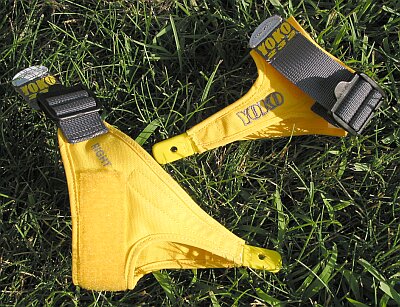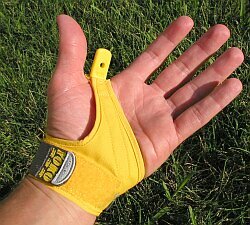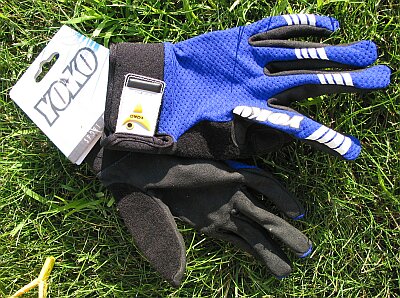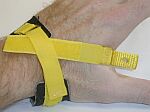News

Products

Field Reports

Stores

Manufacturers
Distributors

Classifieds

|
Field Reports : Yoko Gloves
Name: Bruce Adelsman
Report Filed: August 13, 2002
Products used: Yoko 232 Strap and Rollerski Gloves
When: July/August 2002
Where: Twin Cities/Bemidji
|
Yoko 232 straps
I've used the Yoko 232 system for the past two winters.
I still really enjoy the system and have converted all of
my ski poles, including my classic poles, to the 232 system.
(Read report on my initial experiences with
the 232 system.) Last summer I decided I wanted to switch
to the 232 system for rollerskiing. Unfortunately, Yoko
doesn't make a 232 rollerski glove (and their lightweight
winter glove is too hot for my tastes). Luckily, Yoko does
sell a 232 strap that can be used with any pair of gloves.
I used the 232 strap with the red and black 232 rollerski
glove for most of the summer/fall last year. It worked very
well, and I really enjoyed the switch.
However, the strap wasn't perfect. It seemed a little
crude, with a lot of velcro straps. In fact, getting in
and out of the setup was a bit of a pain. The velcro, as
is its nature, would grab onto everything -- the glove backing,
socks, whatever it was next to.
 In the photos from last winter's Nationals and in the Olympics
I noticed a number of skiers with what appeared to be a
new 232 strap on their gloves. Sure enough, this summer
Yoko came out with a new version of the strap. The mechanism
is the same, so it works just fine with the existing 232
handles, but the strap construction is vastly improved.
Gone are the yards of velcro, and instead much of the strap
is built out of a cloth/nylon material. The edges are all
nicely finished, improving the feel on your hand (especially
bare hands), and giving it a more polished look and fit.
The wrist portion of the strap has a neat loop system with
a small velcro attachment. This allows you to quickly snug
the strap to your wrist without any guesswork.
In the photos from last winter's Nationals and in the Olympics
I noticed a number of skiers with what appeared to be a
new 232 strap on their gloves. Sure enough, this summer
Yoko came out with a new version of the strap. The mechanism
is the same, so it works just fine with the existing 232
handles, but the strap construction is vastly improved.
Gone are the yards of velcro, and instead much of the strap
is built out of a cloth/nylon material. The edges are all
nicely finished, improving the feel on your hand (especially
bare hands), and giving it a more polished look and fit.
The wrist portion of the strap has a neat loop system with
a small velcro attachment. This allows you to quickly snug
the strap to your wrist without any guesswork.
The straps come in different hand sizes, but in a more
simplifed small, medium and large. The plastic nub on the
end of the strap is back, giving it a more positive locking
feel to the system.
Overall, the new straps are a big improvement over the
previous model.
Note: Although this report primarily covers
using these straps for rollerskiing, it should be noted
they will work great in the winter with your favorite pair
of gloves!
Going Naked
 For as long as I've rollerskied, I've always used
gloves. But with the improved 232 straps, I decided
this summer to try rollerskiing without gloves. My
main reason was to see if it would be more comfortable,
in particular in terms of heat. I think I had the
same beliefs as most skiers though: that gloves make
the pole grip more comfortable and your hands less
prone to blisters.
For as long as I've rollerskied, I've always used
gloves. But with the improved 232 straps, I decided
this summer to try rollerskiing without gloves. My
main reason was to see if it would be more comfortable,
in particular in terms of heat. I think I had the
same beliefs as most skiers though: that gloves make
the pole grip more comfortable and your hands less
prone to blisters.
Well, after a month of rollerskiing without gloves,
I can say I really like the feeling. While my hands
do seem to feel cooler, I was most surprised by some
other factors. The most noticeable was the fit. I've
always had some problems with the strap slipping up
my hand as I rollerskied (the winter 232 gloves with
the straps sewn into the glove solve this problem
perfectly). With bare hands, the strap seems to stay
in place on my hands. It's almost like the gloves
were acting as a lubricant, helping the strap to slip.
In addition, I really like the direct contact with
the ski pole grip. It feels firmer, and almost like
I have just a little more control. Ultimately, I didn't
have any more blisters without gloves than I would
normally with them.
There are a few downsides. With the improved grip,
I can also feel the manufacturing edges on the plastic
232 grip. It's not enough to really bother me though,
and I'm guessing that the cork grip version of the
232 grip would eliminate that issue (and probably
feel even more comfortable on bare hands). I also
initially missed the soft backing on the gloves for
wiping sweat, but a bandana on the wrist works just
as well. And of course, if I fall I won't have the
gloves to protect my hands -- and that might be the
biggest factor in favor of wearing gloves.
To recap, here's my list of pros and cons (your mileage
may vary):
Pros:
- Cooler hands
- Better grip (contact)
- Better fit with the strap (less slipping)
Cons:
- Miss the glove backing (for wiping sweat)
- Less protective (for falls)
|
Yoko Rollerski Gloves

Yoko also introduced a new rollerskiing glove this summer.
The blue and black glove is more streamlined and designed
to be cooler. It looks almost like the classic scuba diving
gloves, and fits well. The back is all mesh for improved
ventilation. The leather feels thinner than the previous
versions, yet still provides plenty of padding. And the
glove is smartly reinforced in key points, including the
critical thumb-index finger joint. Finally, a comfortable
and wide wrist strap keeps the glove firmly on your hand.
Overall, the glove feels lighter and cooler than the previous
model, and yet still provides the classic Yoko fit and comfort.
Thanks to Pioneer
Sports for supplying the Yoko 232 straps and Rollerski
gloves for our field reports. Pioneer Sports is the
U.S. distributor for Yoko
Gloves. Check the Yoko Web site for more details on
their full product line.
|
Name: Bruce Adelsman
Report Filed: July 18, 2001
Products used: Yoko 232 Strap
When: June/July 2001
Where: Twin Cities
|
As the rollerskiing season approached this year,
I wasn't looking forward to using my old poles. The pole
itself was decent (although entirely too long, but that's
another story), but it used the old early 90's platform
style Exel grip. The grip always required a few workouts
of hand blistering each spring, and also had to be adjusted
just right to ensure you didn't hammer you hand on the platform.
Since I had enjoyed the Yoko 232 System
this past winter, I was eager to give it a try with my
old poles. While Yoko doesn't produce a rollerskiing glove
with the Yoko 232 system, they fortunately do offer a
strap system. The 232 strap system works with pretty much
any glove, allowing you to convert it into a 232 glove.
It's basically a couple of velcro straps with a soft,
kevlar-like mitt. I haven't tried it yet, but one should
be able to use strap without a glove (i.e. bare-handed).
Pros:
Using the new strap, I found I had the same comfort and
performance as with the glove based system. I am very
happy to say there wasn't any blistering break-in period,
and they felt comfortable even after a 50K rollerski on
a hot July morning.
Cons:
 My biggest gripe is all the velcro adjustments, especially
if you use them with a glove. First there's the velcro
strap on the glove itself. Then the 232 strap has two
velcro adjustments, one for adjusting the pole attachment,
and the other for fixing the strap to the glove. Once
you have the pole attachment strap positioned correctly,
you don't really need to mess with it again. But both
glove straps have to be opened to remove the glove.
My biggest gripe is all the velcro adjustments, especially
if you use them with a glove. First there's the velcro
strap on the glove itself. Then the 232 strap has two
velcro adjustments, one for adjusting the pole attachment,
and the other for fixing the strap to the glove. Once
you have the pole attachment strap positioned correctly,
you don't really need to mess with it again. But both
glove straps have to be opened to remove the glove.
The second gripe is getting the pole attachment strap
set correctly. On the winter 232 gloves, that strap is
sewn into the glove, thus it doesn't require any adjustment.
It's one of those things you find you'll tweak for the
first 5-10K, until you find the right setting that feels
comfortable yet keeps your glove closely attached. The
good news is, once you've got this set correctly, you
won't need to do it again since the strap doesn't need
to be undone to take off the gloves.
Both of these cons could (and hopefully will?) be address
by Yoko if they issue a 232 system rollerski glove next
season.
Bottom line:
While all the velcro straps are a nuisance, I still prefer
the 232 strap and glove combination to any of the previous
pole/strap systems I've used. The comfort is really superior,
and I enjoy the quick release from the pole, allowing
me take a drink of water while I'm still rollerskiing.
Thanks to Pioneer
Sports for supplying the Yoko 232 strap for our field
reports. Pioneer Sports is the U.S. distributor for
Yoko Gloves. Check
the Yoko Web site for more details on their full product
line.
|
Name: Bruce Adelsman
Report Filed: November 30, 2000
Products used: Yoko 232 System
When: November 2000
Where: Snowflake Nordic, Telemark Resort
|
The new Yoko 232 Glove/Grip system takes the
recent strap system changes and brings it to the next
level. Instead of having the strap system attached to
the pole and then having to insert your glove and adjust
the straps to secure the fit, the new Yoko system integrates
the strap directly into the glove. Gone is all the strap
adjusting. Now you really can quickly attach and detach
from the poles (Exel QLS required you to initially attach
and adjust the strap).
When I first looked over the glove/pole system, I
was a bit skeptical. I wondered how the strap would
fit -- would it be too loose or too tight? And the new
thumb platform looked like it could be painful if that
glove adjustment wasn't just right. And then there is
the slightly different way you are supposed to grip
the pole.
With the early snowfall this year, I got my first
crack at using this new system in mid-November up at
Snowflake Nordic in Duluth. Within just a few kilometers,
I quickly realized my preconceptions were all wrong.
The glove/grip system is very comfortable -- in fact,
I'd say its the first system that hasn't caused any
blisters. With the tight integration of the strap and
attachment to the pole, and the new thumb platform,
I found I naturally changed my grip to the recommended
method. You simply don't need to grip the pole as tightly
as other systems, and thus my hands are more relaxed
and less likely to cramp. In addition, I found the thumb
platform was actually quite useful. I could feel my
thumb grasping the platform as I followed through with
the poling motion, and again, it felt quite natural.
Finally, I found the pole living up to the hype: It
feels extremely light, yet very stiff (and strong, as
I fell with it about three times in my first days back
on snow.)
Overall, I am very happy with the new system. I feel
like it's a major step up in comfort, and one less thing
to worry about when I'm out racing. I only have two
knocks on the system:
1) The price -- Since it is new, it is fairly expensive.
Hopefully the cost will come down as it becomes more
widespread.
2) Because the strap is sewn into the glove, you need
specific gloves. The problem here is if you need to
suddenly change gloves. For example, if the race temperatures
are much colder, you might want to use a warmer glove.
Or maybe you warmed up using one pair of gloves, and
now you'd like to switch before the race. Yoko does
sell two versions of the glove, so you can buy a colder
weather version. And they do sell the grips and gloves
separately, so you could have a backup pair of gloves
(and even retrofit old poles).
Side note: When I had the new Yoko poles cut
to my size, I asked John Dyste at Finn
Sisu to cut them to the "appropriate" height for
me. I've been using 162.5cm poles for as long as I've
been skating (I'm 5'10"). John cut the new poles closer
to 158cm. The shorter length makes a huge difference:
I find I'm compressing more, and pushing forward with
more thrust, instead of "pulling" myself with the longer
poles. I've since had my training poles cut to this
length too. After finding I enjoyed the shorter length,
I dug around and found a great article
from Ian Harvey on this very topic in Master Skier
-- looks like I had my head in the sand (snow) for a
couple of years.
Thanks to Pioneer
Sports for supplying the Yoko 232 System for our
field reports. Pioneer Sports is the U.S. distributor
for Yoko Gloves.
Check the Yoko Web site for more details on their full
product line.
|
Name: Margaret Adelsman
Report Filed: August 13, 2000
Products used: Yoko 232 Gloves
When: August 2000
Where: Various locations/conditions
|
I have recently had the opportunity to test-drive
the Yoko 232 rollerski gloves and to offer my perspective
on them. It has been awhile since I've had a chance
to do much rollerskiing, so my base-line for comparison
consists of either bare hands or my old favorite thin
leather Saranac racing gloves. It didn't take many kilometers
to realize that the Yoko gloves are superior to both
of these.
When putting the gloves on, I initially noticed
the feel of the seam where the mesh attaches to the
"leather" surface (this is synthetic Clarino leather).
While it seemed a little scratchy at first, I was
surprised at how I did not notice it while rollerskiing,
nor did I experience any discomfort or chafing from
the seams. In contrast, I found it a great design
to have the meshwork on three sides of each finger
(top and both sides) with Clarino leather only on
the bottom face, allowing for maximal ventilation.
I could actually feel this effect at times, especially
on a breezy day-really a bonus on some of these hot
summer days. The thumb, which tends to take more of
a beating anyway, is completely enclosed in the synthetic
leather material. For my relatively "out-of-shape"
hands, I found the advertised blister-free quality
to be pretty true. Since I was not on snow last year,
and have only rollerskied a little this summer, I
did have a few sore spots (no big surprise), but no
real blisters.
From a woman's perspective, I have been wearing
a size 8 glove, and I would consider my hands to be
M to L in women's sizes. A common problem for me in
the past has been gloves that fit everywhere except
for being too long in some fingers, but I found the
Yoko gloves to be a pretty correct fit. While I had
to pull it over nearly as far as I could, I was also
able to fasten the Velcro wrist strap securely enough
to keep the glove from working down my hand much during
a workout. I think this is also a common problem for
folks with rather narrow wrists.
I haven't washed and dried the gloves yet, but they
have stayed quite soft and supple after several sweaty
outings. The gloves are predominantly black, with
some red backing, but I've not had any problems with
the black color bleeding onto my hands after they
get damp. This has been an issue with some synthetic
leather gloves that I've tried in the past. I look
forward to being able to maintain that soft quality,
especially as I pulled that old favorite pair of leather
gloves out of storage recently and discovered that
only a crinkly mass of hardened leather remained.
So far these gloves have performed very well and have
added one more level of comfort to my off-season rollerski
outings.
Thanks to Pioneer
Sports for supplying a pair of Yoko 232 gloves
for our field reports. Pioneer Sports is the U.S.
distributor for Yoko
Gloves. Check the Yoko Web site for more details
on their full product line.
|
Name: Jay Tegeder
Report Filed: January 27, 2000
Products used: Yoko Windstopper
When: January 25, 2000
Where: Como Golf Course, 10F and windy
|
Fantastic! I skied them in 10F windy conditions
at Como with a liner and they worked perfectly. Then,
I took my liners out after one lap and they still worked
superbly. What's amazing is that they are a very thin
glove, not much thicker than what we use for rollerskiing.
On a scale of 1-10, I'd give them a 10.
|
Name: Bruce Adelsman
Report Filed: January 24, 2000
Products used: Yoko Windstopper, Yoko Profi
When: January 2000
Where: Various locations/conditions
|
I've been using both Yoko Windstopper and
Profi gloves for the month of January.
Windstopper:
In the past few years I've had more problems with
cold hands and haven't found a pair of gloves that
really keeps them warm on training days. Until now,
that is. The Windstopper gloves do indeed provide
excellent warmth and comfort. I've used these gloves
in conditions I normally would have switched to lobster
mit-style gloves. The gloves are very well constructed
and fit good, although I feel the sizings run just
a little larger in this model than the Profi.
The gloves are comfortable enough without being
bulky, allowing me to use them in races as well as
training. I can wear a pair of liners inside the gloves
on really cold days, although I'm not sure it's adding
much -- the gloves really are quite warm. Surprisingly,
they also seem to breathe well as I've not had them
soaking from sweat after a workout.
Profi:
These gloves had a big wow factor on me when I first
put them on. They fit perfectly -- snug, but not too
tight. The neoprene cuff with velcro fastener allows
you to get a perfect fit around the wrist everytime.
The gloves are made out of "Clarino", a synthetic
leather with a lycra backing and some Thinsulate insulation.
The Clarino material is really great stuff: the first
time I skied with these gloves, I immediately noticed
how well they gripped the pole. The palms really grab
without slipping. Plus they seem to breathe well,
keeping my hands warm without getting really wet.
I've raced in Profi gloves a number of times now
and won't go back to my old racing gloves. And, heck,
these gloves just look cool!
Only two minor complaints: I'm use to having somewhere
on the glove I can use to wipe my face/nose during
a race. Without any cloth backing on the Profi, I'm
having to use my ski suit instead. And on the Windstopper,
the Windstopper label tags are really kind of big,
causing a little extra work to slip the ski strap
over them sometimes.
Bottom line: These are the best pairs of ski gloves
I've had in all my years of racing. I expected a lot
of Yoko based on their high reputation, and these
gloves deliver.
|
|
|



